This all started with turnips–the small, white, sweet, perfect-to-eat-like-popcorn Hakurei salad turnips. They are one of the delicious early summer treats, and they are so good in salads made of early greens like arugula and spinach. We first harvested these precious roots about four weeks ago from the glass green house. At first glance they were glorious! They were a promise of summer all wrapped up in a beautiful white package.
And then we started picking.

Minimal damage on these tasty treats! As farm workers, we sometimes get the uglies…but we know it’s what’s on the inside that counts!
Root maggots! ARGH. The farmer had never seen root maggot issues in the glass house, just out in the field. We ended up feeding almost half of that harvest to the cattle because of pest damage. I could see the little white squiggly things in the turnips, eating the food that was meant for people. It was disheartening.
As far as crop destroying insects go, we have it pretty easy in Alaska. The worst are root maggots and slugs, and once in a while flea beetles will cause some leaf damage. Many of these things can be helped through cultural means–we must cover turnips with floating row cover immediately after they are planted or sown; mulch is only used around the hardiest of crops or those that aren’t low to the ground like rhubarb and peas. These measures usually work pretty well, but sometimes other means become necessary. Saucers of beer attract and drown slugs, and we’ve recently been talking about diatomaceous earth or an organic pesticide (the farmer does NOT want to go that route, but may have to for this one crop….)
Some of the bigger (by size and severity) pests on the farm? WEEDS! Weeds everywhere. Chickweed, timothy, clover, wild amaranth, smart weed, chamomile (pineapple weed), jewel weed, stinging nettle, catnip, volunteer lettuces and mustards. The farmer has had to hire on a few emergency weeders to save a few rows, and I’ve been putting in extra hours solely dedicated to weeding. Things are looking up, now, but there were two weeks where we couldn’t tell if there were any plants we had intentionally planted in some beds. Because we are a “beyond organic” operation, we do not use any herbicides, organic or otherwise. We use woman power! Our strong hands, sturdy shoulders and adept hoeing skills are helping tame these beasts. Sometimes, weeding is like cleaning a dirty toilet, or finishing a long essay. it is so immediately rewarding and gratifying. Progress can easily be seen and measured.
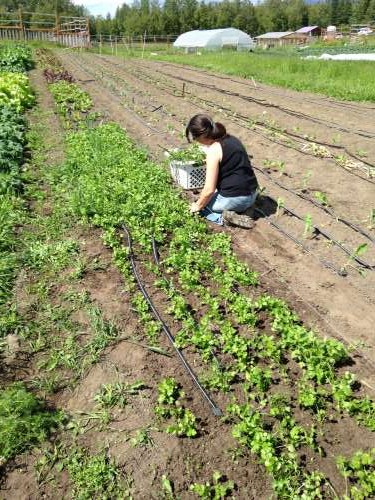
Save the cilantro!

Can you see the stark difference between weed takeover land and blissful onion heaven?
We use wheel hoes, stirrup hoes, hand hoes, onion hoes, hand trowels, knee pads, laundry baskets, and best of all OUR BARE HANDS! I love seeing and feeling the hands of farmers. The perma-dirt makes me happy. I’ve just had an epiphany that I should do a series of photographs of farming hands….it would be beautiful and telling of the true nature of farming and how intimately a farmer knows her land and crops. Since I’ve only been farming a few days per week my hands are decidedly softer and cleaner than they have been in the past. I bet Ava appreciates that.

It’s the DMZ of farming, but the weedless border is advancing!
Onto other pestilent problems–namely the pesky Percy! He’s one of the farm cats. He is very attached to his twelve year old owner, and when she is gone, he is a PEST. Constantly meowing, flopping down on seedlings, and laying exactly where we are presently working. Mocking him doesn’t seem to faze him…at least he’s good looking.
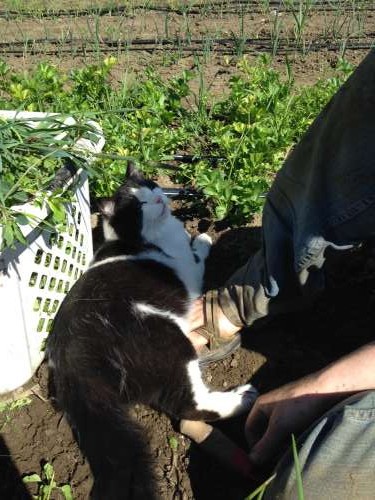
Pesky Percy Pestering Annie
While Percy is a manageable farmyard animal pest, there have been signs of other–larger–pests as well. All three of the farm ducks went missing over the span of several days, probably due to a fox. This was a hard blow to the farmer and her daughters who have had these ducks for more than three years! Poor ducks…but I guess the predators have to eat, too. The chickens were all safe because they roost inside, but the ducks liked to stay out.
Then, the other day, I saw Steve, the farmer’s partner walking very slowly through a few rows looking closely at the crops. I’ve actually never seen Steve looking at plants (he’s an animal guy), so I was confused. It turns out he wasn’t looking at the plants, he was looking at some animal prints. Then I noticed the mess of drip tape and row cover that had been dragged across the field. He was practicing his tracking skills. Everyone was worried that a moose had somehow breached the huge fence without breaking it. However, I think it was determined that it was a dog chasing a cat (Percy, perhaps?). Moose are the biggest (again in size and severity) pest Alaskan farmers face. They love to break into fields, take one bite out of every cabbage, top all of the brussel sprouts and stomp on some beautiful cutting greens before making their escape. The best protection against these guys and gals is a ten foot tall electrified fence. Other silly methods involve tying bars of soap to fences or using predator urine around the perimeter of fields…but the fences work the best and they won’t get washed away by rain.

Despite pests, the crops and veggies are bountiful and beautiful, these are some of the most recent CSA shares. Check out those turnips!
Even in the face of pests of all shapes, sizes and modes of mobility, farmers usually win. We get to eat beautiful, delicious foods. Sometimes they are a little worse for wear, but all of our food ends up the same, right? Give me spots on my apples, but leave me the birds and the bees (Thank you, Joni Mitchell!).
There is always the argument about agriculture vs. wild. And it’s true, there are fewer pests in wildly foraged foods, but they aren’t absent. Blights happen, insects can become overpopulated, bears can get to those blueberries before you! And the worst pest for foraging ever? Mosquitoes…ugh. I try to have at least a little bit of empathy for most pests–they are just doing what they were made to do, right? But mosquitoes can suck it (and they do, from my arms, and ankles, and forehead, and any exposed skin).
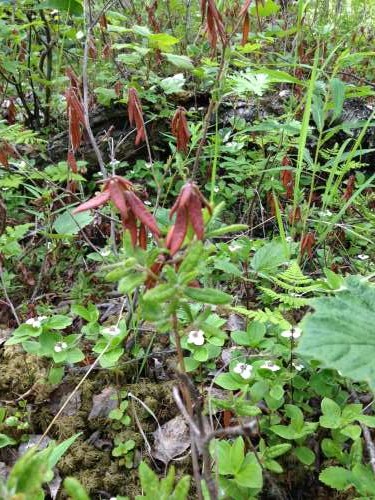
Foraging for Labrador Tea. I don’t know if the mosquitoes make me move faster or just miss good foraging opportunities!
Of course, I have my own adorable little “pest” these days. There are some pests we put up with, without complaint (actually with a whole lot of love and happiness!) for many years. Doing anything with Ava takes at least twice as long as it would normally (this is my new normal), but I am totally okay with that. We wouldn’t have it any other way!

Ava teething on an apple slice! She’s loved apples ever since she could kick my ribs.

Non-Pests are even cuter when dressed up like decorative pillows.
What kind of pests do you have in your neck-o-the-woods? Are there any you just cannot control? Have you come to some kind of wonderful zen-ness about the whole thing? Share your stories, tips and tricks here!
I hope you have a wonderful, safe and fun filled Fourth of July, free of pests of any and all kinds (unless they are adorable babies and children, of course).
Until next time Farmgirls,
Sending you peace and love from AK,
Alex, the Rural Farmgirl





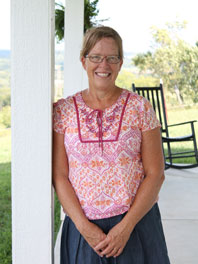
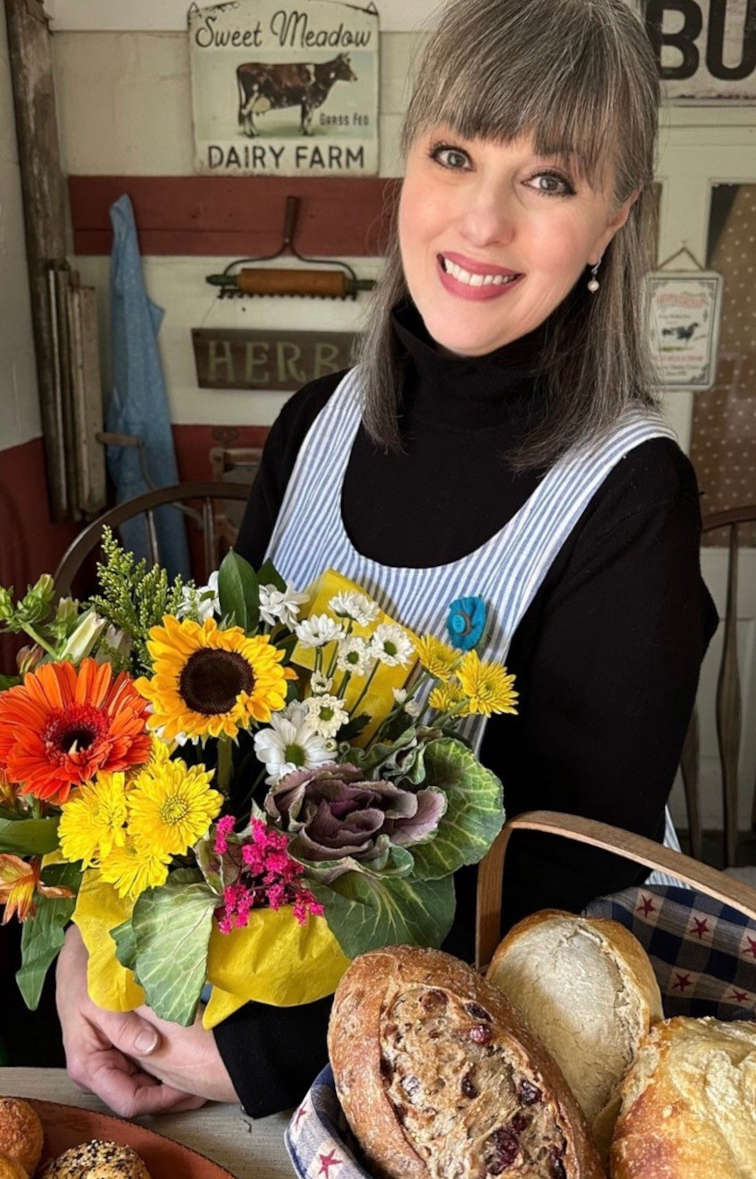




So far we’ve been pretty lucky in the pest department. Flea beetle on cole crops can be bothersome but row cover pretty much takes care of that. Unfortunately it’s tomato and potato late blight we have to guard against and possibly deer. Nice to read your post. I don’t suppose you’re anywhere near Soldotna are you? My brother knows a CSA farmer piton Funny River Road but hey, it’s the largest state in the union so chances are slim!
We are about three hours from Soldotna, so not very close! I hope the farm wasn’t harmed by the funny river fire that was blazing a few weeks ago. I’m super glad we don’t have blight issues up here.
Squash bugs are the bane of my existence! I may just stop planting zucchini and pumpkins for a couple of years.. They don’t seem to bother the cucumbers so much, but how they love those zucchini. Chiggers are also out in droves in Kansas this year – maybe a trade-off for the nice rain we’ve had lately.
WEEDS are my worst pest…we get a few Japanese beetles, that eat bean leaves, and some sort of weird worm got into my few brocolli plants but haven’t traveled over to the cabbage. I’m the weeder here. My husband tries, but he’s disabled and can’t do a lot (which makes him mad, but there’s not much he can do about it)…no one else here has an ounce of patience. My youngest grandson helps a little – at least he takes the weeds and dumps them in the chicken pen when I can catch him! I use NO pesticides, my fertilizer is goat, rabbit and chicken manure composted with whatever weeds that the chickens don’t get and some grass clippings, barn straw gets in the mix… it seems to work. My crops are always later than others because we get less direct sunshine in this hollow than in most places (and the rest of our property is wooded hillsides!) – welcome to the WV hills!
The other day I accused my dear husband of pulling some of my carrots thinking they were weeds….sigh….have any of you seen or remember Bugs Bunny and Elmer Fudd. See Bugs was always traveling here and there and well, ya know a bunny has to eat! Well invariably, Bugs always ended up under Elmer’s garden…that man got around a lot too! And the scene always goes like this…Elmer is standing admiring his fine looking carrots when all of a sudden, the plant starts to shake and bam! disappears! much to Elmer’s shock and frustration….well, I would be Elmer and the varmit would be a gopher. Who knew those little buggers could swipe a whole carrot plant with such stealth and speed. Gophers and I are not friends! With that said, an old remedy my Grandmother used was Ivory Liquid dish soap and castor oil, whipped, and a half cup added to a gallon of water and poured down every gopher hole you can find. It doesn’t poison anything, they hate the smell and it just chases them off. As this is not a poison icky, it will take a few applications.It is working for me, no more Elmer moments so far.
Thanks Diann!
Oh yeah, Bugs was a good bug-like pest to ol’ Elmer. Do the gophers steal your carrots from underground? If so, that is kind of awesome in a gophers-have-evolved-in-a-very-smart-way kind of way. Thanks for the poison free remedy! I’ll have to share it with my mom who has gopher issues. Ivory soap seems to be the go to for pest related remedies, I wonder why?
I grew up on a farm in west northwest Minnesota. Way back when…. I am 75 five now, so… I loved the farm (dirt poor, as it was .. But we kids didn’t know that) . I mostly did outside work with my brothers. Gardens, making hay, picking any fruit that grew, milking cows, cleaning barn…whatever.. But loved my doll (no plural here) and cooked and baked too. No such thing as “busy work” then. We were all needed. I Thank God for those days. Gave me a wonderful foundation as I went on to become a nurse (RN) and had a good work ethic throughout my career. I so enjoy reading your blog. Helps bring back long-forgotten memories. Thank You
Thanks for sharing these fond memories with us. Where in northwest Minnesota? My family is from Fargo and I’ve spent a good amount of time in Detroit Lakes. Kids and farming go pretty well together, I think! work gets accomplished while kids are outside, they get to use their imaginations and build up immune systems, too. Plus, it’s hard to beat a hands-on experiential education. Thank you!
Hi Alexandra!!
I was so excited to read your post today, especially the part when you said,” just had an epiphany that I should do a series of photographs of farming hands….it would be beautiful and telling of the true nature of farming and how intimately a farmer knows her land and crops” and you could elaborate on what a day in the life of a farmer really looks like! We are hopefully moving to Montana soon, and I would love to farm and I always have questions when we take our long road trips to Montana from LA, as to what do farmers do in their day, what is that field of crops that we just passed, how long do they work in a day etc… that would be a joy to read as I have enjoyed all of ypour posts:)
Kind Regards,
Deborah
I’ve been thinking about that “epiphany” a lot of over the past two weeks! Perhaps I’ll start during the next month when I’m in the upper midwest! I just need to learn a bit more about photography (or ask dear hubby to edit photos for me). Thanks for the kind words!